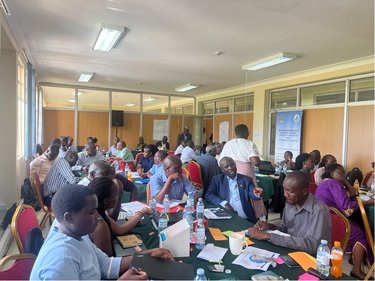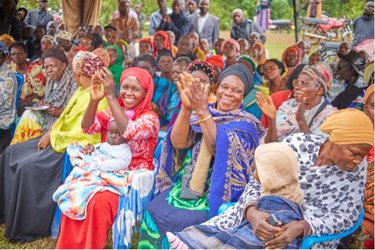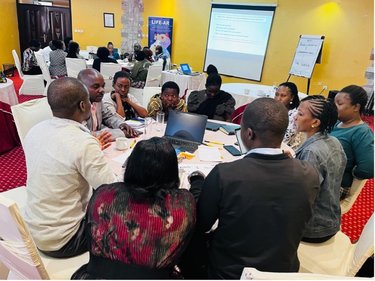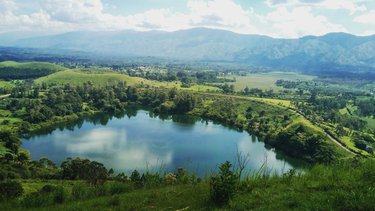A pressing need for adaptation
Uganda, a landlocked country in East Africa with a population of over 45 million, has an economy largely driven by agriculture, though the services and industrial sectors are growing.
As a Least Developed Country (LDC), Uganda faces challenges such as poverty and infrastructure gaps, but it has made significant progress in education, health, and economic reforms. Despite its negligible contribution to global emissions (0.099 percent), Uganda is highly vulnerable to the impacts of climate change. Ranked 13th in vulnerability and 160th in readiness, the country faces increasingly frequent and severe weather events such as floods, droughts, and erratic rainfall. These extreme events are causing landslides, water shortages, and crop failures and other impacts, which threaten Uganda's socio-economic progress.
LIFE-AR as a means to strengthen the country’s ability to adapt to climate change
Following a request by the state minister for Environment in 2018, Uganda officially joined the LIFE-AR initiative in November 2020. A task force was established to draft a concept note on how LIFE AR would be implemented in Uganda. The concept note recommended the Devolved Climate Finance (DCF) mechanism as the preferred approach to deliver climate finance for local adaptation and resilience building. This mechanism aligns with Uganda's devolved governance system, integrates climate change into local planning, and supports the country’s National Climate Change Policy, Nationally Determined Contribution (NDC) and National Development Plan. The initiative aims to build Uganda's climate resilience by supporting community-driven climate action, with at least 70% of funding directed toward local priorities.
LIFE AR in Uganda will strengthen in-country capabilities, systems and institutions for climate action, ensuring that there’s sustained funding for climate action and that at least 70% of this funding supports community priorities.
Achievements so far
The country is currently in the Test & Evolve phase where the delivery mechanism will be piloted in 12 districts using a phased approach.
This phase was preceded by an establishment phase that lasted about 2 years. During this phase, the country, informed by a baseline study, constituted multisectoral governance structures including the steering committee, the task team, secretariat, and working groups.
Using Multisectoral Whole of Government, and Whole of Society working groups (WGs) and a highly multistakeholder consultative process, Uganda designed a country tailored delivery mechanism to channel funds (Devolved Climate Finance Mechanism) to the local levels and a complementary framework for Monitoring, Evaluation and Learning (MEL).
Design of the mechanism entailed a series of meetings, research and consultations at both national and local government level, as well as a visit to Kenya to benchmark and learn from their DCF experience. The DCF WG also developed criteria to guide selection of the first pilot districts clustered around exposure to hazards, vulnerability and gender and equity considerations which led to the selection of 12 pilot districts across the country’s 4 water management zones.
Official implementation in the pilot districts began in April 2024 with a training of trainers on LIFE AR and the DCF mechanism.

This was followed by widespread sensitization and awareness raising activities at the three levels of district local government in the first four pilot districts, which is important for getting community buy-in and ownership of the programme.
The district technical teams facilitated selection of 3 target sub-counties per district using five core criteria namely: frequency and severity of hazards, vulnerability, gender and equity considerations, existing climate change initiatives and population. Similar criteria were used by sub-county technical teams to select three target parishes (1 per sub-county).
In addition, communities participated in the election of parish climate change committees (PCCCs) within their respective parishes.

The PCCCs are recognized by the National Climate Change Act, and they are critical in facilitating local engagement and community-centred decision-making. Parishes are the lowest administrative unit and therefore closest to the communities.
Continuous learning and monitoring have been integrated into the programme, with workshops and feedback sessions assessing progress and identifying lessons for improvement. A recent reflection session, facilitated by the MEL Working Group, evaluated district-level achievements and generated insights for refining future activities. Work is ongoing to develop tools for operationalizing the national MEL plan and DCF pilot results framework.

Moving forward
Ongoing district-wide climate risk and vulnerability assessments will establish a baseline for tracking LIFE-AR's progress and better understanding district-level climate needs. These will be followed by parish-specific risk and vulnerability assessment workshops using a participatory planning toolkit (modified from Pamoja voices climate-resilience planning toolkit) to identify the climate priorities of men, women, and youth.
The PCCCs are being trained on their roles and responsibilities in implementing the DCF mechanism, including tools and approaches for facilitating community consultations and decision-making.

